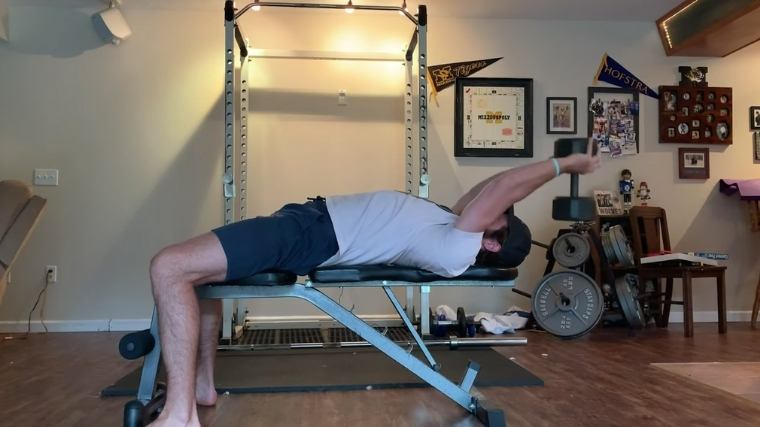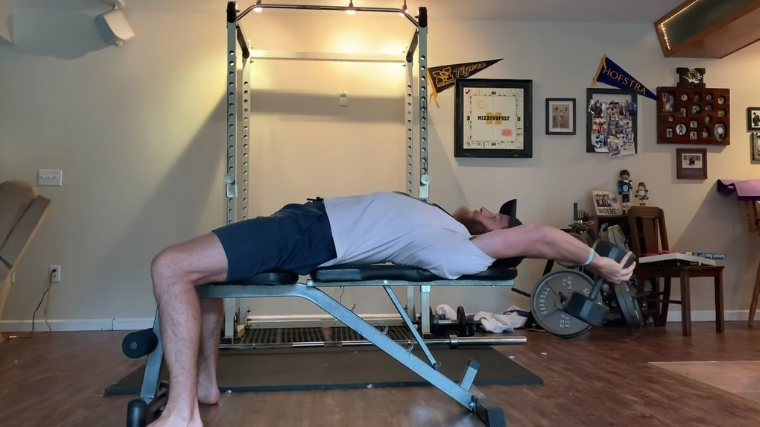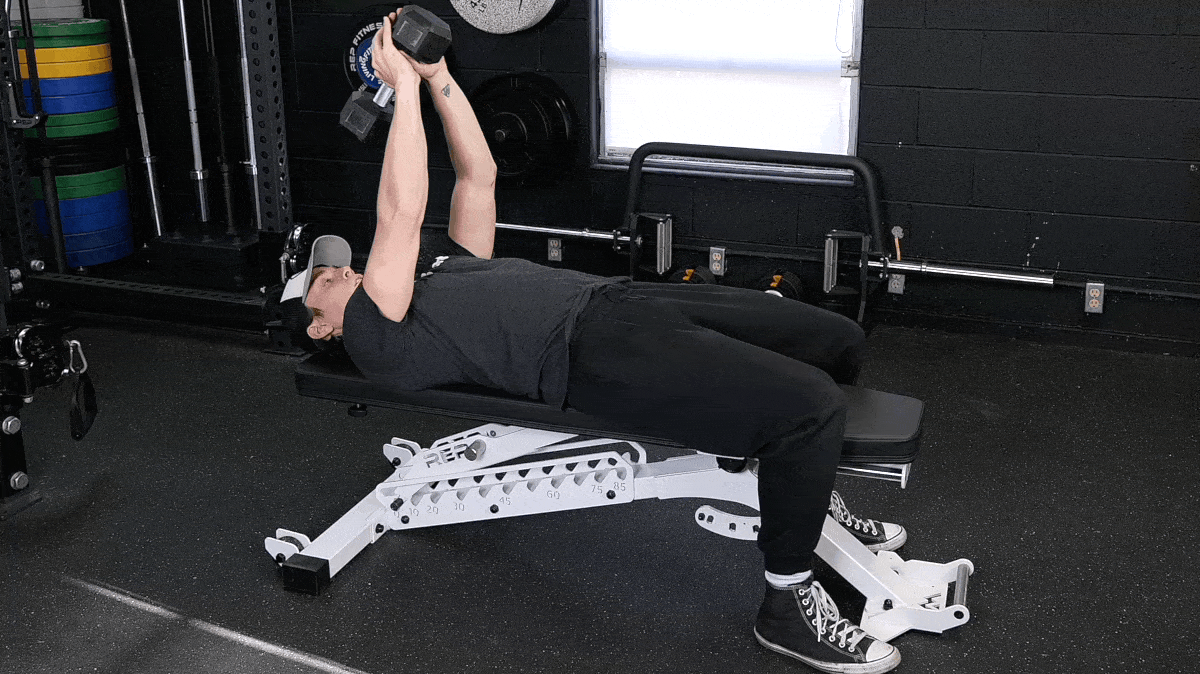Serious strength athletes and steadfast gymgoers know that prioritizing heavy compound movements will always do more to get you bigger than single-joint accessory exercises. But isolation moves are not useless training afterthoughts — they can produce pretty big gains.
The backs and chests of Arnold Schwarzenegger, Ronnie Coleman, and Dorian Yates are all proof that the dumbbell pullover — a tried-and-true accessory movement from the Golden age of bodybuilding — can build serious muscle mass and increase overall upper body strength potential.
In this article, we will go through everything you need to know about the dumbbell pullover, a move to build a stronger torso, including:
- How to Do the Dumbbell Pullover
- Dumbbell Pullover Sets and Reps
- Common Dumbbell Pullover Mistakes
- Dumbbell Pullover Variations
- Dumbbell Pullover Alternatives
- Muscles Worked by the Dumbbell Pullover
- Benefits of the Dumbbell Pullover
- Who Should Do the Dumbbell Pullover
- Frequently Asked Questions
Editor’s Note: The content on BarBend is meant to be informative in nature, but it shouldn’t take the place of advice and/or supervision from a medical professional. The opinions and articles on this site are not intended for use as diagnosis, prevention, and/or treatment of health problems. Speak with your physician if you have any concerns.
Dumbbell Pullover Video Guide
Check out BarBend’s in-depth video guide on how to execute perfect dumbbell pullover reps.
[Related: Seal the Deal on a Bigger, Stronger Back with the Seal Row]
How to Do the Dumbbell Pullover
Below is a step-by-step guide on how to perform the dumbbell pullover, along with tips on how to use proper form.
Step 1 — The Set-Up

Lie face up on a weight bench. Plant your feet firmly planted on the ground. Maintain a slight arch in your lower back. Hold a light to a moderate dumbbell at one end with both hands. Slightly bend your elbows and press the weight over your chest.
Form Tip: Set yourself as you would for a bench press — squeezing your legs, abs, and shoulder blades together.
Step 2 — Reach Backwards

Without letting your lower body or hips move, lower your arms back. Maintain a slight bend in your elbows. Keep lowering the weight until you feel a stretch in your chest muscles and lats. Reach back as far as you comfortably can. Make sure to focus on feeling the stretch of your lats, chest, and triceps.
Form Tip: Depth in this movement is not a good initial marker of an effective range of motion. Focus on feeling the stretch first, as every shoulder joint and lifter is different.
Step 3 — Raise the Load and Repeat

Focus on pulling your arms back into position with your lat muscles. Again, keep your elbows just slightly bent throughout all phases of the lift. After each rep, try to assume a slightly deeper stretch.
Form Tip: Focus 100 percent on feeling your muscles doing the work. If you don’t feel your chest and back muscles doing the majority of the work, odds are you are performing the dumbbell pullover incorrectly.
Dumbbell Pullover Sets and Reps
With an accessory lift, you’re unlikely to push yourself to develop a one-rep max. And with a move like the dumbbell pullover, you’ll be pulling a heavy dumbbell right over your face — this is not a lift you want to train to failure. Finding a balance between load and volume in your training will help you maximize your gains while minimizing the risk of accidents.
- For Strength: Try three sets of six to eight reps, using a weight that you know is manageable with three reps in the tank.
- For Muscle Mass: Perform three or four sets of eight to 12 reps, leaving two or three reps in the tank.
- For Endurance: Aim for two or three sets of 12 to 15 reps, moving slowly and deliberately with each rep.
Err on the side of being conservative about your weight choices until you’re very confident in the move. Even then, always make sure your grip isn’t too exhausted when you’re performing this exercise. Yes, you want the gains, but no, you most definitely don’t want any mistakes with a dumbbell above your face.
Common Dumbbell Pullover Mistakes
Don’t let the simplicity of the dumbbell pullover fool you — there are ways to mess it up. Here are two rookie mistakes to avoid.
Forcing Your Range of Motion
If you have serious overhead mobility limitations, you may want to limit the range of motion for this exercise or opt for a different movement.
View this post on Instagram
However, with the dumbbell pullover, you only need to lower the weight as far down until you feel your lats and chest contract. If you have trouble finding this range, start by lowering the weight to the point that’s comfortable, hold it, and then come back up. During your next rep, lower the weight just a smidge farther, and hold. Repeat this until you can find an acceptable range of motion for your body and abilities.
Shooting the Hips off the Bench
Keep your hips grounded throughout this exercise to prevent any undue stress on your lower back. Like when performing skull crushers or the bench press, keep your hips planted on the bench. Keeping your hips static can actually promote better mechanics by limiting forced ranges of motion, leading to injuries in extreme cases.
Lifting Too Heavy
It’s often tempting to load up with the heaviest possible dumbbells, but that’s not a great strategy for this move. If you go too heavy, you risk recruiting your biceps and shoulders and possibly straining a muscle. Because you’ll be moving through a vulnerable range of motion, you don’t want to risk a heavy dumbbell pulling too hard, too fast when the weight travels back and over your head.
Further, you’ll be holding the dumbbell over your face at the top of this lift. One of the best ways to avoid accidents and strains here is by keeping the weight in a lighter range.
Dumbbell Pullover Variations
Below are three dumbbell pullover variations to build chest and back strength and hypertrophy, and improve shoulder stability.
Dumbbell Pullover on a Stability Ball
By performing the dumbbell pullover on a stability ball, you help reinforce glute and core stabilization throughout the range of motion. Many lifters will perform this movement with excessive spinal extension, often masking that they don’t possess the mobility to perform the move well.
Additionally, performing this movement from a stability ball increases the end range of motion and places a larger stretch upon the muscles to further stimulate muscle growth.
Dead Bug Dumbbell Pullover
The dead bug is an excellent exercise to reinforce core stability and positional awareness.
By combining this exercise with the dumbbell pullover, you can increase core stability and reinforce the proper technique of the pullover.
Single-Arm Dumbbell Pullover
The single-arm dumbbell pullover is done similarly to the regular pullover, with the exception that the lifter focuses on one arm at a time.
In doing so, you can often increase muscle activation and awareness of proper technique and set up. Since you’ll be performing this move unilaterally, you’ll also be able to target and reduce strength and muscle imbalances from side-to-side.
Dumbbell Pullover Alternatives
The dumbbell pullover is a unique exercise that is tough to replicate. If you cannot perform a full overhead press or pull-up with proper stability in your upper back, you’ll likely want to attack those issues before diving into the pullover.
Below are three dumbbell pullover alternatives that can be used to improve back and chest hypertrophy while you’re building up the strength and mobility you need.
Straight-Arm Cable Pushdown
The straight-arm cable pushdown is a more back-dominant movement that can increase back and serratus development.
While it doesn’t train your chest muscles, you can superset this movement with a chest flye for a similar overall training effect.
Dumbbell Chest Flye
The dumbbell flye is a single-joint exercise that targets the pectoral muscles and increases scapular stability and control. This is all similar to the dumbbell pullover.
While this movement doesn’t target your lats, it can be paired with other movements, like wide-grip pulldowns, to target the lats.
Incline Bench Rope Cable Pullover
The incline bench cable pullover increases the range of motion of the standard dumbbell pullover while minimizing shoulder pain (for some individuals) due to the pull line.
Using a cable machine can also help maximize your time under tension because of the consistent resistance throughout the exercise. That’s a recipe for even more hypertrophy.
Muscles Worked by the Dumbbell Pullover
The dumbbell pullover trains opposing muscles — the chest and back — at once. Here’s a breakdown of the primary muscles that the dumbbell pullover works.
Serratus Anterior
The serratus is one of the primary muscle groups targeted during the dumbbell pullover.

The serratus anterior — located on the upper rib cage — pulls the scapula forward and aids in stabilizing your shoulders during heavy pulls, carries, squats, and presses.
Latissimus Dorsi
Your lats span the entire length of your back and pull your arms to your sides (known as flexion). During the dumbbell pullover, your lats are the primary mover, as they pull your arms back to the starting point. They are also worked during the lowering phase of the lift, as they’re stretched under load.
Triceps
Due to the slight elbow bend, your triceps are under load throughout the duration of the dumbbell pullover. You’ll work them, but they’re not the main mover during this exercise.
Pectorals
You’ll use your pectorals — AKA, your chest — during the concentric (lifting) phase of the dumbbell pullover. This is often why the dumbbell pullover is programmed on chest days. However, you can include them on most days throughout your training program.
Benefits of the Dumbbell Pullover
As long as you have the requisite mobility and stability to perform the move safely, the dumbbell pullover is one of those moves that fits into a whole range of programs. It’s beneficial for lifters and athletes of all types for a variety of reasons.
Builds a Bigger Chest and Back
The dumbbell pullover can help increase chest, back, and serratus size and strength at the same time. This movement is one of the more well-known bodybuilding staples done by seven-time Mr. Olympia winner Arnold Schwarzenegger, and rightfully so.

By performing this exercise for moderate to higher repetitions, you can increase the stretch placed upon your upper body muscles and provide a great stimulus for growth.
Improves Full-Body Stability
As you lower the dumbbell behind you, you’ll need to brace your glutes and core muscles to prevent yourself from rocking off of the bench. You must also contract your scapulae and upper back muscles to stabilize the load throughout the movement. This learned stability will carry over to similar exercises like dumbbell flyes and chest presses.
Improved Shoulder Mobility
The dumbbell pullover can improve shoulder mobility in that it stretches the lats and triceps — two muscle groups often responsible for impeded overhead mobility. Achieving such a deep stretch will also help you establish greater stability and control, enabling your body to feel capable of achieving and supporting this deeper range of motion.
Who Should Perform the Dumbbell Pullover
Below are a few groups of athletes that can benefit from including dumbbell pullovers within their training programs.
Strength and Power Athletes
Increasing back strength, scapular stability, and overhead capacities can improve pressing performance for both powerlifters and weightlifters.
- Powerlifters: Developing the lats and serratus can improve performance in the big three as they enable you to brace your back more effectively. For example, during the back squat, the muscles developed with dumbbell pullovers will let you set your base more effectively.
- Strongmen and Strongwomen: The same benefits that powerlifters experience carry over into strongman. However, the added shoulder mobility and stability gained from dumbbell pullovers can improve performance during overhead carries, farmer’s carries, and pressing movements such as log presses.
- Olympic Weightlifters: The dumbbell pullover can be a great way to establish increased stability for overhead movements like the snatch and clean & jerk. This also assists in positional strength during pulls, as well as front squats, overhead squats, and back squats.
Competitive CrossFit and Functional Fitness Athletes
Competitive CrossFit and functional fitness athletes can include the dumbbell pullover within training programs if they are looking to increase chest and back development. That said, a steady regimen of bench pressing, dips, rows, and chin-ups will usually suffice.
General Population
Beginners may be better off sticking with the basics, like pull-ups, pull downs, and seated rows. These moves are generally less complicated and offer more bang for the buck. That said, after months of solid training, the dumbbell pullover can be added into a program. For everyday gymgoers, the benefits are the same as above.
Pull in Those Gains
The dumbbell pullover may not be as fancy of a back-builder as the bent-over row, nor as glamorous a move as the bench press. But training your back and chest at the same time is a rare opportunity to keep your push-pull game as even as you can. You’ll be giving yourself a challenging accessory move and a well-balanced program and physique all at the same time. Try adding the dumbbell pullover to your repertoire in your next training cycle, and pull your gains up through the roof.
FAQs
Figuring out the ins-and-outs of a new move can be tricky. If you’ve still got questions about the dumbbell pullover, we’ve got answers.
Can you do the dumbbell pullover without a bench?
Yes, but it’s not ideal. The bench allows you to achieve a full range of motion. Performing these on the floor will drastically limit your range of motion, and therefore the stretch on your lats and chest. If the floor is your only option, still go for it — you’ll still get something out of it.
Avoid using unstable surfaces that aren’t completely secure, as you definitely do not want to slip out of position during this move.
Can you lift too heavy during the dumbbell pullover?
Yes. Your focus should be on performing this in a full range of motion so that you feel a deep stretch on your muscles. If you find yourself more focussed on lifting heavy and not achieving a contraction, go lighter and keep your elbows less bent.
Is the dumbbell pullover necessary in most programs?
To be honest, no. While this can be helpful for some individuals when placed in warm-ups or accessory blocks, it is certainly not necessary. Some lifters may even find they have discomfort when doing them.
Experiment with these, and understand they support bigger movements and muscles. They should not be prioritized in the same way squats, deadlifts, presses, rows, and sports specific work is, in any program.